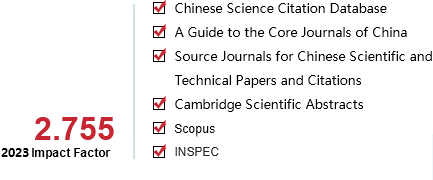[1]PU Xingcheng,SONG Xinlin.Improvement of ant colony algorithm in group teaching and its application in robot path planning[J].CAAI Transactions on Intelligent Systems,2022,17(4):764-771.[doi:10.11992/tis.202108020]
Copy
Improvement of ant colony algorithm in group teaching and its application in robot path planning
CAAI Transactions on Intelligent Systems[ISSN 1673-4785/CN 23-1538/TP] Volume:
17
Number of periods:
2022 4
Page number:
764-771
Column:
学术论文—智能系统
Public date:
2022-07-05
- Title:
- Improvement of ant colony algorithm in group teaching and its application in robot path planning
- Keywords:
- improved ant colony algorithm; group teaching optimization; path planning; mobile robot; pheromone update; heuristic function; path simplification; regression strategy
- CLC:
- TP273
- DOI:
- 10.11992/tis.202108020
- Abstract:
- To solve the problems of slow convergence speed and easily falling into local optimization, a novel improved ant colony algorithm is proposed based on a group teaching optimal algorithm (GTACO). The improved ant colony algorithm is optimized in three aspects. Firstly, the group teaching optimization algorithm is used to improve the fitness function of the ant colony algorithm to enhance the searching ability of global solutions. Simultaneously, a new fallback strategy is designed to deal with the U-shaped deadlock and ensure the feasibility of the solution. Secondly, a novel updating strategy for dynamic pheromones is adopted to avoid falling into local optimization of the algorithm by updating the path pheromone value after each iteration. Finally, the simplification operator of the path is applied to shorten the length of the path by simplifying the redundant corners into linear paths. Simulation experiments show that the improved algorithm can effectively increase the ability of path planning in convergence speed and accuracy for mobile robots.
- References:
-
[1] WANG Jiaying, LUO Bing, ZENG Ming, et al. A wind estimation method with an unmanned rotorcraft for environmental monitoring tasks[J]. Sensors (Basel, Switzerland), 2018, 18(12): 4504.
[2] ZHANG Mingyi, LIU Xilong, XU De, et al. Vision-based target-following guider for mobile robot[J]. IEEE transactions on industrial electronics, 2019, 66(12): 9360–9371.
[3] GAO Yingding, HU Tianyang, WANG Yinchu, et al. Research on the path planning algorithm of mobile robot[C]//2021 13th International Conference on Measuring Technology and Mechatronics Automation. Beihai: IEEE, 2021: 447?450.
[4] ALI M A H, MAILAH M. Path planning and control of mobile robot in road environments using sensor fusion and active force control[J]. IEEE transactions on vehicular technology, 2019, 68(3): 2176–2195.
[5] DIJKSTRA E W. A note on two problems in connexion with graphs[J]. Numerische mathematik, 1959, 1(1): 269–271.
[6] GOLDBERG A V, KAPLAN H, WERNECK R F. Reach for A*: efficient point-to-point shortest path algorithms[C]//Proceedings of the Eighth Workshop on Algorithm Engineering and Experiments. Florida: Society for Industrial and Applied Mathematics, 2006, 6(2): 129?143.
[7] 楼传炜, 葛泉波, 刘华平, 等. 无人机群目标搜索的主动感知方法[J]. 智能系统学报, 2021, 16(3): 575–583
LOU Chuanwei, GE Quanbo, LIU Huaping, et al. Active perception method for UAV group target search[J]. CAAI transactions on intelligent systems, 2021, 16(3): 575–583
[8] 徐玉琼, 娄柯, 李志锟. 基于变步长蚁群算法的移动机器人路径规划[J]. 智能系统学报, 2021, 16(2): 330–337
XU Yuqiong, LOU Ke, LI Zhikun. Mobile robot path planning based on variable-step ant colony algorithm[J]. CAAI transactions on intelligent systems, 2021, 16(2): 330–337
[9] 夏小云, 周育人. 蚁群优化算法的理论研究进展[J]. 智能系统学报, 2016, 11(1): 27–36
XIA Xiaoyun, ZHOU Yuren. Advances in theoretical research of ant colony optimization[J]. CAAI transactions on intelligent systems, 2016, 11(1): 27–36
[10] GAO Wei. Modified ant colony optimization with improved tour construction and pheromone updating strategies for traveling salesman problem[J]. Soft computing, 2021, 25(4): 3263–3289.
[11] LIN Wang. Path planning for unmanned wheeled robot based on improved ant colony optimization[J]. Measurement and control, 2020, 53(5/6): 1014–1021.
[12] LI Xue, WANG Lei. Application of improved ant colony optimization in mobile robot trajectory planning[J]. Mathematical biosciences and engineering:MBE, 2020, 17(6): 6756–6774.
[13] PU Xingcheng, XIONG Chaowen, JI Lianghao, et al. 3D path planning for a robot based on improved ant colony algorithm[J]. Evolutionary intelligence, 2020: 1–11.
[14] 梁凯, 毛剑琳. 基于改进蚁群算法的室内移动机器人路径规划[J]. 电子测量技术, 2019, 42(11): 65–69
LIANG Kai, MAO Jianlin. Path planning of indoor mobile robot based on improved ant colony algorithm[J]. Electronic measurement technology, 2019, 42(11): 65–69
[15] QIN Ling, PAN Yi, CHEN Ling, et al. An improved ant colony algorithm with diversified solutions based on the immune strategy[J]. BMC bioinformatics, 2006, 7(4): 1–8.
[16] YU Miao. A solution of TSP based on the ant colony algorithm improved by particle swarm optimization[J]. Discrete & continuous dynamical systems-S, 2019, 12(4/5): 979–987.
[17] DAI Xiaolin, LONG Shuai, ZHANG Zhiwen, et al. Mobile robot path planning based on ant colony algorithm with A* heuristic method[J]. Frontiers in neurorobotics, 2019, 13: 15.
[18] ZHU Shinan, ZHU Weiyi, ZHANG Xueqin, et al. Path planning of lunar robot based on dynamic adaptive ant colony algorithm and obstacle avoidance[J]. International journal of advanced robotic systems, 2020, 17(3): 1–14.
[19] WU Hongguang, GAO Yuelin, WANG Wanting, et al. A hybrid ant colony algorithm based on multiple strategies for the vehicle routing problem with time windows[J]. Complex & intelligent systems, 2021: 1–18.
[20] TAO Yong, GAO He, REN Fan, et al. A mobile service robot global path planning method based on ant colony optimization and fuzzy control[J]. Applied sciences, 2021, 11(8): 3605.
[21] ZHANG Yiying, JIN Zhigang. Group teaching optimization algorithm: a novel metaheuristic method for solving global optimization problems[J]. Expert systems with applications, 2020, 148: 113246.
[22] DORIGO M, MANIEZZO V, COLORNI A. The ant system: an autocatalytic optimizing process[R]. Milan: Dipartimento di Elettronica, Politecnicl di Milano, 1991.
[23] DORIGO M, MANIEZZO V, COLORNI A. Ant system: optimization by a colony of cooperating agents[J].IEEE transactions on systems, man, and cybernetics, part B. 1996, 26(1): 29?41.
[24] 任红格, 胡鸿长, 史涛. 基于改进蚁群算法的移动机器人全局路径规划[J]. 华北理工大学学报(自然科学版), 2021, 43(2): 102–109
REN Hongge, HU Hongchang, SHI Tao. Global path planning of mobile robots based on improved ant colony algorithm[J]. Journal of North China University of Science and Technology (natural science edition), 2021, 43(2): 102–109
[25] PU Xingcheng, XIONG Chaowen, ZHAO Longlong. Path planning for robot based on IACO-SFLA hybrid algorithm[C]//Proceedings of 2020 Chinese Control and Decision Conference. Hefei: IEEE, 2020: 652?629.
- Similar References:
Memo
-
Last Update:
1900-01-01
